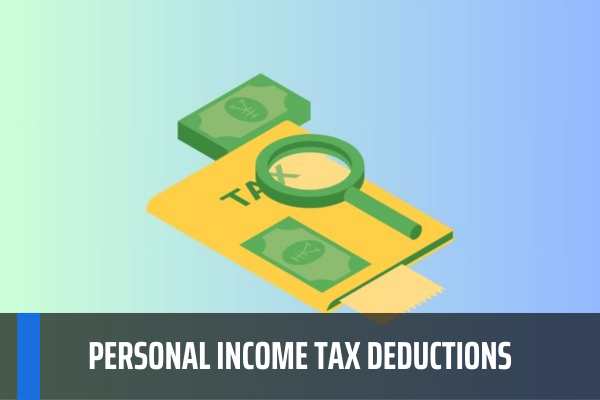How much are the current personal income tax deductions in Vietnam? What is the Declaration Form for Commitment of Non-occurrence of Personal Income Tax?
How to calculate the personal income tax deductions in Vietnam?
Based on the provisions in Article 1 of Resolution 954/2020/UBTVQH14, the current deductions include:
- Personal deduction: 11 million VND/month (132 million VND/year);
- Dependent deduction: 4,4 million VND/dependent/month.

How much are the current personal income tax deductions in Vietnam? What is the Declaration Form for Commitment of Non-occurrence of Personal Income Tax?
Where to download the Declaration Form for Commitment of Non-occurrence of Personal Income Tax in Vietnam?
Currently, the Declaration Form for Commitment of Non-occurrence of Personal Income Tax is based on Form 08/CK-TNCN issued with Circular 80/2021/TT-BTC.
Download the Declaration Form for Commitment of Non-occurrence of Personal Income Tax here.
Which cases are eligible for personal income tax deductions in Vietnam?
Based on Article 9 of Circular 111/2013/TT-BTC, there are two deductions when paying personal income tax: Personal deduction and Dependent deduction. The specific cases for each deduction may vary.
Personal deduction:
- The taxpayer that has multiple sources of income from wages and business shall calculate the personal deduction for himself in a place at a time (considered a full month).
- The foreigner being a resident in Vietnam shall make personal deduction from January (or the month of arrival if the person comes to Vietnam for the first time) until the month in which the labor contract expires and that person leaves Vietnam in the tax year (considered a full month).
Example 8: Mr. E is a foreigner that comes to work in Vietnam continuously from March 01, 2014. On November 15, 2014, the labor contract expires and Mr. E goes home. Mr. E is present in Vietnam for 183 days from March 01, 2014 until the date of departure. Thus in 2014, Mr. E is a resident and may make a personal deduction from January until the end of November 2014.
Example 9: Mrs. G is a foreigner who comes to Vietnam for the first time on September 21, 2013. On June 15, 2014, the labor contract expires and Mrs. G leaves Vietnam. Mrs. G is present in Vietnam for 187 days during the period from September 21, 2013 to June 15, 2014. Thus in the first tax year (from September 21, 2013 to September 20, 2014), Mrs. G is considered a resident in Vietnam and may make a personal deduction from September 2013 until the end of June 2014.
- If the person has not made personal deduction or the deduction does not cover 12 months in the tax year, the person may make deduction for 12 months before settling tax.
Deduction for dependants
- The taxpayer may make deductions for his or her dependants if the taxpayer has applied for tax registration and been issued with the tax code.
- When registering deductions for dependants, the taxpayer shall be issued with tax codes for dependants and make preliminary deductions in the year from the registration date. The dependants that are registered before this Circular takes effect are still eligible for deductions until being issued with tax codes.
- If the taxpayer has not made deductions for dependants in the tax year, the deductions for dependants shall be made from the month in which the custody is given when the taxpayer settles tax and registers deductions for dependants. Deductions for other dependants, who are defined in Point d.4 Clause of this Article, must be registered by December 31 of the tax year, otherwise the deduction for the whole tax year shall not be made.
- The deduction for a dependant shall apply to only one taxpayer in the tax year. Where multiple taxpayers have the same dependant to provide for, they shall reach an agreement on the person that makes the deduction for such dependant.
- Dependants include:
+ Children, legitimate adopted children, illegitimate children, stepchildren. To be specific:
+ Children under 18 years of age.
Example 10: A child of Mr. H born on July 25, 2014 is considered a dependant from July 2014.
+ Children from 18 years of age and over that are disabled and incapable of work.
+ Children studying in Vietnam or overseas in universities, college, vocational schools, including children from 18 years of age and over in high schools (including the period awaiting university enrolment result from June to September in 12th grade) that have no income or have the average monthly income of ≤ 1.000.000 VND in the year from all sources.
+ The taxpayer's spouse that meets the conditions in Point dd Clause 1 of this Article.
+ The taxpayer’s parents, parents-in-law, stepparents, legitimate adoptive parents that meet the conditions in Point dd Clause 1 of Article 9 of Circular 111/2013/TT-BTC.
+ Other dependants that the taxpayer has to provide for, who meet the conditions in Point dd Clause 1 of Article 9 of Circular 111/2013/TT-BTC, including:
+ The taxpayer’s brothers and sisters.
+ The taxpayer’s grandparents, aunts, uncles.
+ The taxpayer’s nieces and nephews.
+ Other people to provide for as prescribed by law.
+ A person that meets the conditions below shall be considered a dependant mentioned in Point d.2, d.3, d.4 Clause 1 of Article 9 of Circular 111/2013/TT-BTC:
+ The person of working age must meet all conditions below:
+ The person is disabled and incapable of work.
+ The person has no income or his average monthly income from all sources does not exceed 1,000,000 VND.
+ The people outside working age shall have no income or their average monthly income from all sources shall not exceed 1,000,000 VND.
LawNet